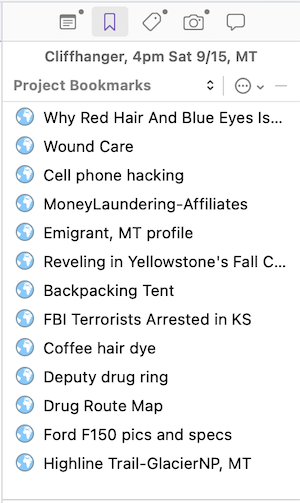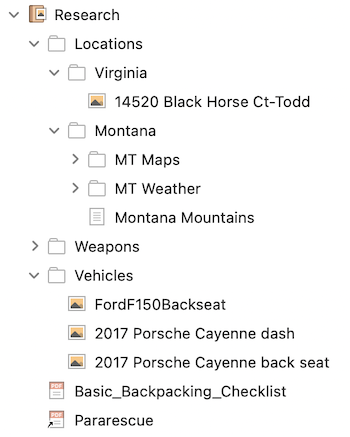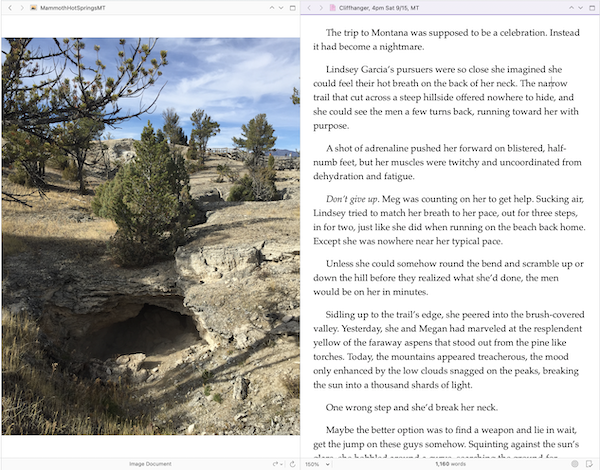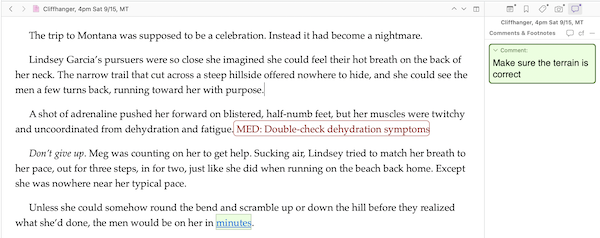Scrivener Scenario: Organizing Your Research and Notes
By Gwen Hernandez | May 25, 2021 |

Research is one of my favorite things about being a writer. But keeping all of those notes and sources in order, and accessible, can be a challenge. I frequently get asked how Scrivener can help, so let’s take a look at some of the features that make containing, organizing, and finding your research materials easy.
Luckily, I’ve previously covered each of these functions in detail, so I’ve linked to the relevant posts below. Hopefully, this article will give you some ideas how those capabilities you may have written off in the past can help you write your book.
Getting Your Research Into Scrivener
One of the most valuable things to me about Scrivener is that a project can contain all of the supporting materials for a manuscript in one place. Pictures, web pages, documents, and your own notes can be imported or linked for quick access.
Importing
When you import a file, it becomes part of the project. It is a copy of the original file that is no longer linked to the original. This is true for web pages, or any picture, document, or PDF.
The advantages of importing are that you can view an item without having to leave Scrivener—or see a web page without being online—and you can view a file side-by-side with your manuscript while you write (more on that later).
The disadvantage is that anything you import will increase your project file size accordingly. If you have limited disk space where you keep your Scrivener projects, or where you back them up, this might be a consideration.
Because they’re small, I tend to import any text documents I want. For PDFs and images, I only import those that are frequently viewed or not too large. The rest—along with web pages—are added to bookmarks instead.
Using Bookmarks
Bookmarks are a great alternative to importing rarely accessed, or overly large, files and web pages. A bookmark is a link to the file or web page, and provides you quick access without adding items to the Binder or bloat to your project.
Using a bookmark for a web page or file also makes sense when you always want access to the most current version, rather than the static copy you’d get if you imported.

Bookmarked websites
From here on out, though, we’ll discuss how to work with imported files.
Keeping It All Organized
Files that you’ve imported can be organized in several ways. The most straightforward one is to put them into folders by topic (e.g., Cars, Locations, Cooking, Weapons), or type (e.g., Interviews, Articles, Book Excerpts, Notes). For a short list of documents, this may not be necessary, but if you’ve amassed an alarming number of files, folders will allow you to collapse portions of your Research list so you don’t feel visually overwhelmed.

A sampling of imported supporting materials for my last book
If that doesn’t work for you because you have things that overlap categories, you might still put them in folders to keep you sane, but also consider using keywords to help you locate them without a lot of scrolling.
For example, you might have notes from an interview with a baker, who also gave you good insight into what it’s like to live in Oakland. You could put the notes in either your Occupations or Locations folder, and also add the keywords Occupation and Location (or Baker and Oakland, whatever) to the document. Then, when you need to find all of your materials about the Oakland, you can do a simple keyword search.
Also, if you ever can’t remember where you put a file, review Scrivener’s various search options.
Utilizing Your Research
To me, the best part about having my supporting materials in Scrivener is that I can view them anytime. Even better, is that I can view a file side by side with the one I’m writing. To do so, open both files in Split Screen, and have at it.

Split screen with a photo on the left and a scene document on the right
Marking Spots that Need More Research
If you come across a spot in your manuscript that needs more research, you don’t have to run off and do it now. (Rabbit hole, anyone?) Just mark that place with an annotation or a comment.

Annotation in red, comment link and bubble in green
When you’re ready to spend a day digging for information, you can run through all the annotations or comments at once to see what kinds of research you need to do.
Do you have any questions about using Scrivener for research (or anything else)? Feel free to share other ways you use Scrivener to keep it all together.
[coffee]









I’ve been using Scrivener for years, and I still always learn something new from your posts. This time it was annotations/comments.
Thank you!
Great, CP! Annotations and comments are one of my top 5 things I love about the software. Thanks!
Oh wow, thank you for this. I have no idea why I always forget about the bookmark option. Your reminder is timely. Thankfully, I use my desktop so project size has yet to become a problem.
I research, of course, but I also worldbuild because I write fantasy and have files that I move from project to project, most of them Scrivener files. It takes a few seconds. I often write in composition mode and can have floating (reference) screens to one side if needed, even maps. Thanks again!
Christina: There’s so much you can do that it’s easy to overlook something like bookmarks. And I used the term research a lot, but I have all kinds of other supporting materials too.
If you’re always using the same files in your new projects, you might consider creating a project template with those files already in it. ;-)
I love using composition mode to keep me in the zone too. Sounds like you have a great setup!
I’m new to Scrivener and the power of the program. Learning it is like eating an elephant, I have to take one small bite at a time.
Thank you so much for this nutritious bite.
Bob: That’s a perfect way to look at it! Too many people try to take it all in at once, then get overwhelmed and quit.
Thanks Gwen. That is exactly how I approach research. Only three other things of note that I do. The first is that I usually only copy in URLs to webpages (unless I want to capture something at a specific point in time such as today’s weather which I want a static view of. Secondly, I make sure to use Project Bookmarks instead of Document Bookmarks so they are easily accessible across chapters / scenes, and I have a Research document template I use when adding a new research topic to the project. This provides a consistent structure to each Research document outlining the research objective, a section for outlining the specific questions I want answered and a list of URLs and File links for things I did not want to copy into the Scrivener project but be able to access easily.
I also have in my Research Folder a list of ‘experts’ by research topics who I can access to answer questions. Having moved from writing non-fiction to fiction, the topic of organizing research well within Scrivener was a bit of a learning curve for me, but really worth going up that curve!
Thanks for sharing your process, Steve! I definitely recommend project bookmarks over document bookmarks in most cases, and outlined why they’re usually better in the linked bookmarks post.
Using a document template for research is a great idea if you have a specific approach. Glad you stopped by!
Gwen, thanks for this helpful post. I’ve been using Scrivener for over a year now and I’m always open to tips.
Before Scrivener I took to copying and pasting the URLs of sites I used for research into a project notes Word doc. With Scrivener I paste those URLs into a Notes or Research text file for the project.
ALso, I appreciated Steve’s helpful comment.
Hi, Bob! Pasting the links into a document is definitely another good option if you don’t like using bookmarks. Thanks for sharing!
Thank you for these helpful posts, Gwen! Like Bob, I’m still taking in Scrivener one bite at a time.
Barbara, I’m glad they’re helping! :-)
I am still learning and your tips and your book are very useful. I have a question about annotations in relation to to-do files. My research project consists of some twenty different chapters. For each chapter, there are items that need additional research. I have now made separate to-do files in each research chapter/folder.
What I would like, is to be able to get an overview of all my to-do’s, to attack one of them according to available time. Is there a way to do that? Or would it be better to change the to-do items (four to ten for each chapter) into annotations and then group these annotations?
Thanks, Marc! If you have a separate document for each chapter’s to-do list, you could give each of the to-do files a label or status of To Do, then do a project search for that value, and save that search as a collection. That would allow you to see all of the to-do lists in one place. Select them all and view in Screenings mode and you can see them as a continuous list.
If you’d rather use something like annotations, I’d recommend comments instead because you can click on your Draft folder, go to the Comments pane in the Inspector, and view all of the comments in your manuscript in one list. Click on a comment and it jumps you right to that spot in the manuscript.
If you need more help on any of those concepts, I have a list of all my blog posts at https://gwenhernandez.com/scrivener-tips. HTH!